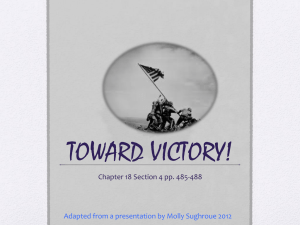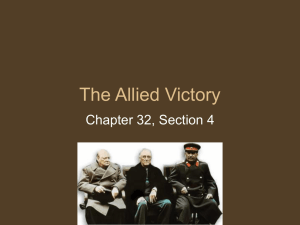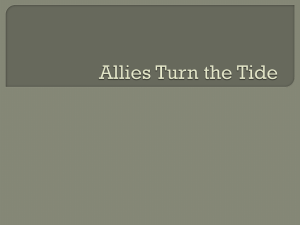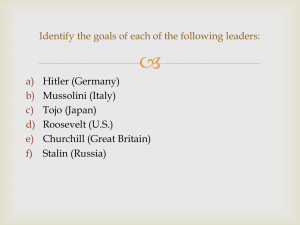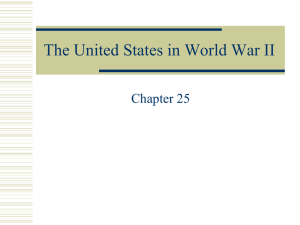WWII Powerpoint
advertisement
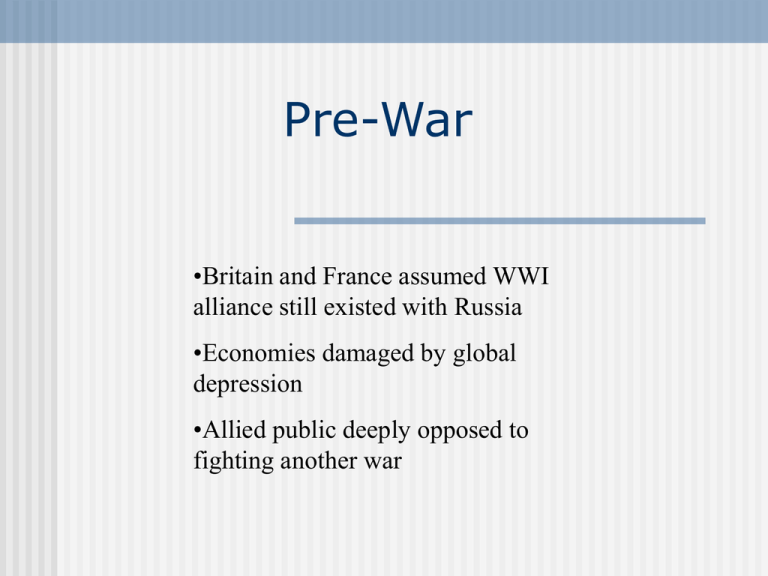
Pre-War •Britain and France assumed WWI alliance still existed with Russia •Economies damaged by global depression •Allied public deeply opposed to fighting another war Czechoslovakia and Appeasement •September 1938- Hitler invades the Sudentenland, a part of Czechoslovakia •On September 30, the Munich Agreement Britain and France agree to allow Hitler’s occupation of the Sudentenland, in return Hitler promised to stop invading other countries •March 14, 1939 Germany invades the rest of Czechoslovakia- Allies do nothing Non-aggression Pact •Between Germany and the U.S.S.R. •August 23, 1939 •Temporary agreement which secured Hitler's eastern front •If Germany attacked Poland the Soviet Union would not come to Poland’s aid- in fact, Soviet Union would be allowed to take part of Poland as their own Germany Invades Poland •September 1, 1939 •Germany invades Poland •Warsaw succumbs on September 28 •Soviet invasion from the East Britain and France Declare War on Germany •September 3, 1939 •Resulting from Germany invading Poland Germany Invades Denmark and Norway •April 9, 1940 •Surrendered to Germany Belgium and the Netherlands •May 10, 1940 •Netherlands surrender on May 15 • Belgium on May 28 Germany Invades France •May 14, 1940 • French relied upon the Maginot Line which was a system of heavily armed steel and bunkers stretching hundreds of miles along the German boarder •Germans outflank the line by going north of it, through Belgium •French surrendered June 22,1940 Battle of Britain •September 1940 to May 1941 •Series of air battles between German and British air forces fought over Britain. •Initially Hitler wanted to destroy the RAF but after he failed to do that he began to bomb British cities Germany invades the Soviet Union •June 22, 1941 •Germany makes rapid advances but the frigid Russian winter and “scorched earth” tactics slows the advance •By September 8, Germany surrounded Leningrad •October 2, 1941 the Germans drove on Moscow Battle of Stalingrad •1942 – 1943 •German forces were defeated in their attempt to capture the city of Stalingrad in the Soviet Union. •Turning point on the Eastern Front Allied Troops Land in Algeria and Morocco •November 7, 1942 •In Operation Torch which applied western pressure as British attacked from East •Axis forces in N. Africa surrender May 13, 1943 Allied Troops Land in Italy • Allies invade Sicily in July 1943 •Mussolini’s government falls from power that month •Italy surrenders on Sept. 8 but the German army moves into Italy to protect Hitler’s Southern Flank •Sept 9, the allies land in Italy Allied Troops Land in Normandy on D-Day •June 6, 1944- Operation Overload -- the largest land, sea and air invasion in history •Creates a third front confronting Nazi Germany •August 1944, Paris is liberated •By the end of summer France, Belgium, and Luxembourg are under Allied Control The Plot to Assassinate Hitler Fails •Attempt on July 20, 1944 as a bomb is placed under a table during a meeting. •The bomb detonates and injures Hitler, but does not kill him •Hitler retaliates with a purge of military officers that he suspects of disloyalty – this purge further harms the German war effort Battle of the Bulge •December 16, 1944 to January 25, 1945 • Last major German offensive creates a “bulge” in the Allied lines that is 80 miles long and 50 miles deep •Allies push back the offensive and drive into Germany Hitler Takes His Life in Berlin •April 30, 1945 •Hitler kills himself as Russian troops surround Berlin Germany Surrenders to Allies in Reims, France •Unconditional surrender of Germany on May 7, 1945 •May 8, 1945 declared V-E Day Pearl Harbor • December 7, 1941 •Surprise attack by Japan at Pearl Harbor, Hawaii •More than 2,400 killed •180 aircraft destroyed, 19 ships sunk •Sub pens, refueling stations, repair facilities unharmed America Responds •December 8, 1941, Roosevelt asked Congress to declare war on Japan to avenge the “date which will live in infamy.” After Pearl Harbor, Japanese seize Dutch East Indies, Burma, Wake Island, Guam, and the Philippines in early months of 1942 Battle of the Coral Sea •May 1942, in the Pacific •American carrier-based planes bombard the Japanese fleet aimed at invading New Guinea’s southern coast – The Japanese counter attack with their carrier-based planes •Allies lost more ships than Japanese, but Japan turned its invasion forces around – halting Japan from expanding southward near Australia Aftermath of Battle of the Coral Sea •American Carrier Yorktown is badly damaged (estimates put repairs at three months) and its aircrew almost gone •Japanese Carrier Shokaku is lightly damaged •Japanese Carrier Zuikaku is undamaged but needs to replenish 40 percent of its air crew •Yorktown is repaired in 68 hours with a new flight crew and plays a pivotal role in the Battle of Midway • Japanese Carrier Shokaku takes three months to repair •Japanese Carrier Zuikaku takes more than a month to replenish their airwing Battle of the Midway •June 1942, three US carriers (including the Yorktown) attack four Japanese carriers to stop invasion of Midway Island •US Airplanes sink all four Japanese carriers, while the US loses only the Yorktown •Essentially ends the offensive capabilities of the Japanese in the Pacific American Strategy Island Hopping • forces went island to island in pitched battles against the Japanese. •Some islands were ignored as US forces isolated Japanese forces by cutting them off from sea or air supply •Goal was to move closer and closer to Japan’s mainland Battle of Guadalcanal •Allies discover Japanese building airfield on Guadalcanal in the Solomon Island •10,000 US Marines attack on August 7, 1942 •Marines take the airfield and hold it against repeated Japanese attacks •Japan lost 25,000 men, US about 2,000 •First Japanese land lost Island Hopping US takes Guam- July 1944 Phillipines- January through June 1945 Iwo Jima- February through March 1945 Okinawa- April through June 1945 June 1944 US begins bombing Japanese mainland Firebombing of Tokyo in March 1945, killing 83,000 civilians Japan refuses to surrender Atomic Bomb Pros •Estimated casualties of invading the Japanese mainland estimated at almost a million American deaths •A conventional invasion with strategic bombardments could take months and devastate Japan Cons •The Atomic Bomb would kill and sicken hundreds of thousands of people •The US would be the first (and so far only) country to use such a devastating weapon Defeat of Japan •August 6th, 1945- United States dropped the atomic bomb on Hiroshima, Japan. 100,000 killed instantly, 100,000 die wounded •Japan didn’t surrender and the United States dropped a second bomb on Nagasaki on August 9- 40,000 deaths •The Japanese surrendered August 14, 1945

